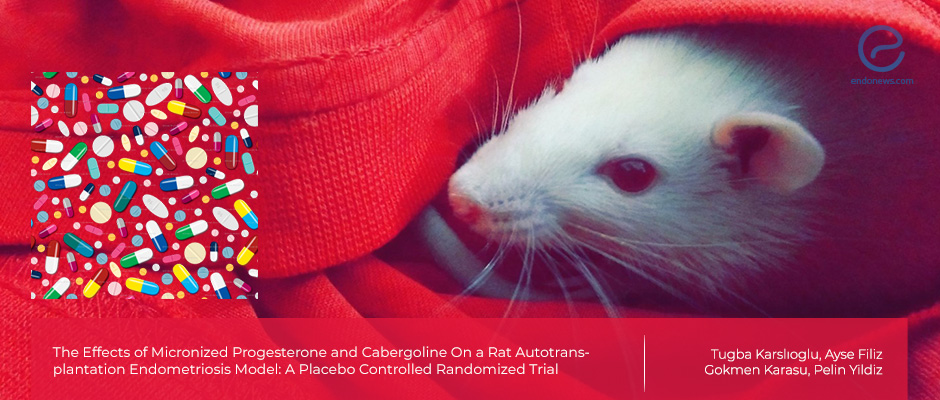Cabergoline or Progesterone not Effective in Rat Model of Endometriosis
Jul 10, 2020
Longer treatment times and different administration methods may have an effect; more studies are needed.
Key Points
Highlights:
- Cabergoline or micronized progesterone has no effect on the size of endometriotic implants in a rat model of the disease.
Importance:
- Further studies are needed to test the potential benefits of these treatments in other animal models of endometriosis.
What's done here:
- Researchers used a rat model of endometriosis to test the effect of cabergoline and micronized progesterone on the size of endometriotic lesions four weeks after oral treatment.
- A total of 21 adult albino rats were divided into 3 groups, one being control and the other two cabergoline and micronized progesterone.
Key results:
- Endometriosis implants regressed in all rats, either treated or those that were untreated.
- There was no statistically significant difference in the size of the implants before and after treatment among the groups.
- There was no difference with regard to IL-6 and TNF-α staining among groups.
Limitations:
- Rats may not be the best model to use as unlike primates including humans, the regeneration during the endometrial cycle, and the growth of new vessels that take place in case of implantation and placentation.
- The study only looked at the effect of treatment on newly formed endometriotic implants. Long-term endometriotic implants may respond differently to the treatment.
Lay Summary
Oral treatment with cabergoline or micronized progesterone for four weeks is not effective in the regression of endometriotic implants in a rat model of the disease. This is according to a study published in the "Journal of Investigative Surgery".
Cabergoline is a compound that mimics the action of the signaling molecule dopamine. It also inhibits the formation of new blood vessels, a biological event that is important for the development of endometriosis.
Micronized progesterone is progesterone that has been modified to increase its available surface area, thereby increasing its absorption in the intestines and making more it effective when taken orally. Micronized progesterone is nontoxic, has few side effects, and is less expensive than synthetic progestins.
In order to investigate the effects of cabergoline and micronized progesterone on endometriotic lesion size, a team of researchers led by Dr.Yildiz at Bezmialem Vakif University in Istanbul, Turkey used a rat model of endometriosis.
The researchers implanted endometrial tissue in the lining of the abdomen of 21 animals. They then waited eight weeks and confirmed the formation of endometriosis by laparotomy, or surgical incision into the abdominal cavity. The researcher then separated the rats into three groups: the first group received treatment with cabergoline, the second with micronized progesterone, and the third group did not receive any treatment. This time, the researchers waited for four weeks and then measured the volume of the implants to see whether any of the treatments led to a regression in their size.
The results showed that the size of the endometrial implants regressed in all three groups and that there was no significant difference in the size of the implants before and after treatment in any of the groups.
The researchers concluded that oral treatment with cabergoline and micronized progesterone for four weeks has no effect on endometriotic implant regression in a rat model of the disease.
They said that treatment for longer periods of time or via a different route may have a different effect and should be investigated. They added that either treatment for longer durations or using other mammals closer to humans such as baboons may also be considered in the future to test the potential effect of the two treatments on endometriotic lesions.
Research Source: https://pubmed.ncbi.nlm.nih.gov/31906754
Cabergoline progesterone treatment rat model endometrial lesion regression

